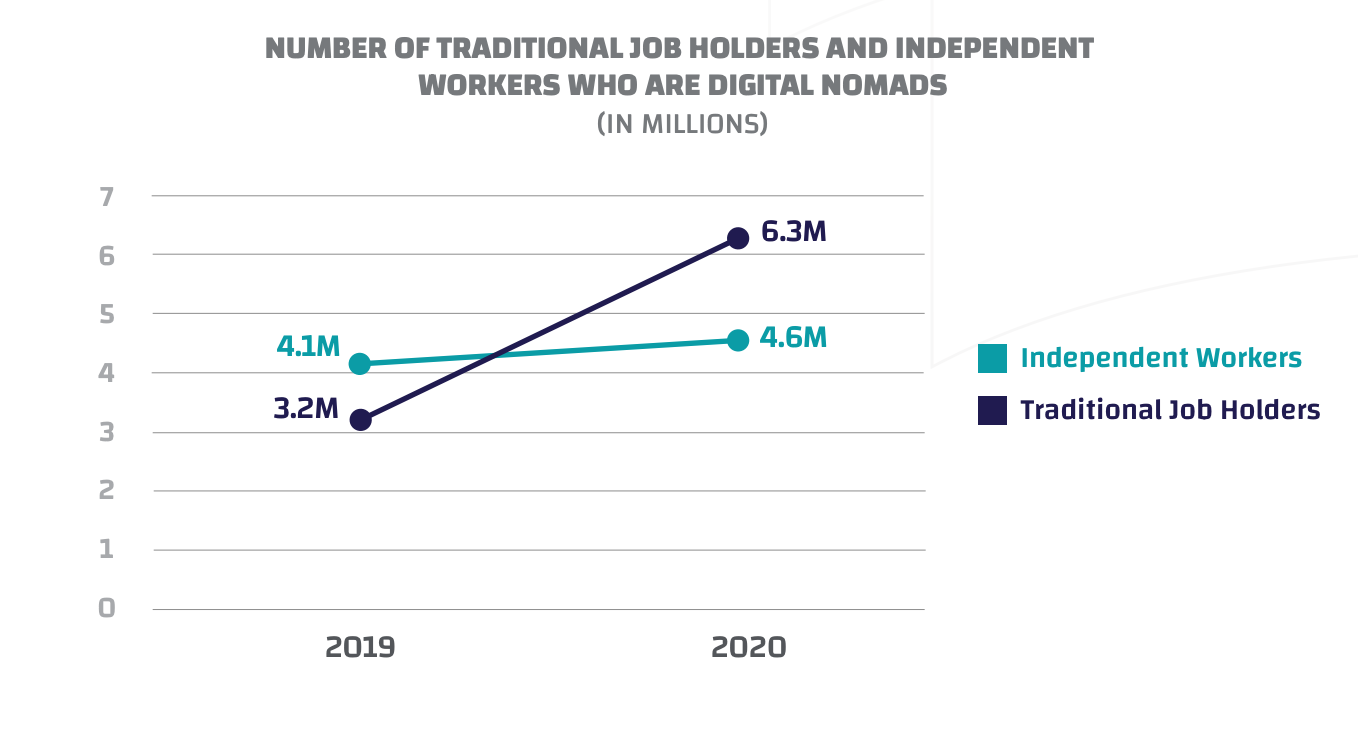- Will the pent up demand for adventure and the rise of remote working lead to a digital nomad boom?
- A study by MBO revealed that the number of “traditional” workers turning to digital nomadism grew by a whopping 96%, from 3.2 million in 2019 to 6.3 million in 2020.
- Although interest in digital nomadism has spiked, it’s unlikely to become the new normal.
A digital nomad is described as someone who uses technology to work remotely in different places. While the archetypal digital nomad might combine their work with international travel, others may choose to travel within their country of residence.
The trend for digital nomadism is being propelled by the gig economy, a model whereby temporary and flexible jobs are common and companies rely on contractors and freelancers.
The coronavirus lockdowns are curbing travel and forcing people to stay closer to home. But they are also acting as a catalyst for the widespread adoption of remote and hybrid working.
Many future of work-ists are contemplating what this all means for digital nomadism. Will the pent up demand for adventure and the rise of remote working lead to a digital nomad boom?
What we do know is that people’s interest in the topic is peaking.
Google search data for the term “digital nomad” suggests that the topic has been increasing in popularity since 2014 – with a few peaks and troughs.
For example, there was a temporary dip in searches when the first Covid-19 lockdowns hit, with interest quickly picking up again when lockdown restrictions began to ease.

The number of people actually making the transition into digital nomadism is surging too.
A study on digital nomadism in the US by MBO partners found that 10.9 million workers described themselves as digital nomads in 2020, an increase of almost 50% from 2019.
The rise in popularity of digital nomadism means that the term itself is expanding to include a wider variety of workers – not just freelancers.
Following the widespread adoption of remote working by large companies, employees who work a 9-5 are replacing office culture with life on the open road.
MBO’s study revealed that the number of “traditional” workers turning to digital nomadism grew by a whopping 96%, from 3.2 million in 2019 to 6.3 million in 2020.
The number of independent (freelance/contractor) workers also grew, but only by 12%. It’s safe to assume that this is because the group already had the option to work remotely before the pandemic.

As well as surveys on the subject, we can also look to the travel and hospitality industry for signs as to whether or people are jumping on the digital nomad trend.
In a report published in May, Airbnb revealed their number of long-term stays (28 days minimum) has almost doubled year-on-year.
The volume of Airbnb guest reviews mentioning remote work has increased by 520% globally year over year, and 55% of long-term stay bookers who were surveyed in 2021 said they were working or studying during their stay.
Airbnb predicts that many people might not continue to work solely from home as we emerge from lockdowns, but will look to beach cottages, forest cabins, and suburban homes outside of the city for a change of scene and to work productively (see also: workcations).
Although lots of us are also still choosing to travel domestically during the pandemic, some governments are offering incentives to digital nomads from other countries. In 2020, Estonia opened applications for its Digital Nomad Visa (DNV), which allows international citizens in Estonia to work for an international employer or as a freelancer.
Over on the Portuguese island of Madeira, the Government of Madeira, StartUp Madeira, and acclaimed digital nomad Gonçalo Hall have launched a new Digital Nomad Village. The initiative, which is currently set to run until 2022, aims to attract digital nomads to the island.
Although interest in digital nomadism has spiked, it’s unlikely to become the new normal.
Let’s be realistic: only individuals with certain types of jobs, a large amount of freedom and enough money will be afforded the opportunity to embrace digital nomadism. Based on McKinsey research, “60-70% of the workforce has zero opportunity” to work remotely at all.
One study also shows that over 60% of businesses are planning to adopt hybrid working post-pandemic, meaning employees will have to work in the office part-time.
If business owners do decide to go fully remote, they will need to make sure they have a robust (and evolving) remote work strategy and digital nomad policy to ensure that telecommuters within their organisation have access to equal opportunities.
What could the future of digital nomadism look like?
So, based on the research and anecdotal evidence, we can expect to see:
- Employees becoming digital nomads – with the widespread acceptance of remote working, it’s reasonable to assume that millions more traditional workers will consider embracing digital nomadism in the coming years, probably temporarily.
- More domestic travel – Lots of digital nomads are expected to stay closer to home, at least for the short-term, as the impact of the pandemic is felt around the world. Hybrid work models will require employees to travel to the office for at least a couple of days a week, so mini workcations could become a new trend.
- Longer-term stays – Due to the ongoing nature of the pandemic, many digital nomads are opting to stay in one place for longer. As well as helping to mitigate the spread of Covid-19, staying put for a month or more enables nomads to explore a place in more depth and gain a better understanding of its culture and customs.
- Government incentives – Economies around the world are suffering due to coronavirus travel restrictions. In a bid to attract visitors again, we can expect to see more governments offering incentives to digital nomads, such as special visas and access to business support and incubation services.
- Coworking space utilisation – Despite the pandemic, many coworking markets globally are experiencing increased demand. Between 2017 and Q2 2020, coworking footprint almost doubled to 86.0 million square feet, and we expect this to increase year-on-year as people adopt remote working and digital nomadism.

Image credit: Coen van de Broek
The issue of climate change could have a significant impact on the habits of digital nomads, especially in light of the UN’s landmark scientific report on climate change.
The report reveals that emissions of greenhouse gases from human activities are responsible for around 1.1°C of warming since 1850-1900. It also finds that averaged over the next 20 years, global temperature is expected to reach or exceed 1.5°C of warming.
Approximately 2.4% of global CO2 emissions come from aviation, and combined with other gases and the water vapour trails produced by aircraft, the industry is responsible for around 5% of global warming.
Although this doesn’t seem like a huge contribution at first glance, the fact that only a tiny percentage of the population flies frequently could prompt some digital nomads to rethink their approach to work and travel.People are already changing their travel habits in an attempt to reduce their carbon footprint.


 Dr. Gleb Tsipursky – The Office Whisperer
Dr. Gleb Tsipursky – The Office Whisperer Nirit Cohen – WorkFutures
Nirit Cohen – WorkFutures Angela Howard – Culture Expert
Angela Howard – Culture Expert Drew Jones – Design & Innovation
Drew Jones – Design & Innovation Jonathan Price – CRE & Flex Expert
Jonathan Price – CRE & Flex Expert














